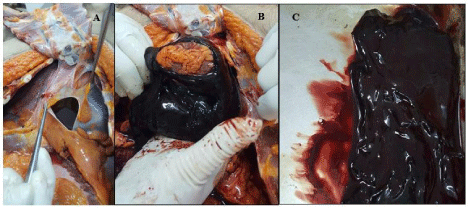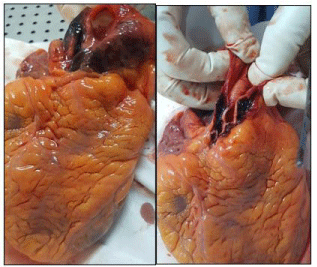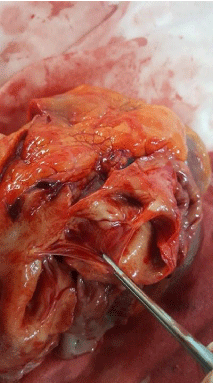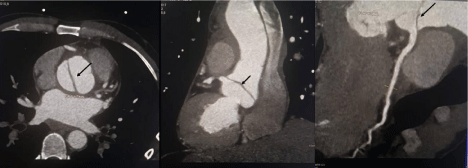
Case Report
Austin J Clin Case Rep. 2019; 6(4): 1153.
Acute Aortic Dissection in Young Patients without any Predisposing Factors
Nihel F1*, Malek Z1, Wiem BA1, Selma C2, Wiem F3, Sami B1, Zouhair H1 and Samir M1
1Department of Forensic Pathology, Habib Bouguiba University Hospital, Tunisia
2Department of Cardiology, Hedi Chaker University Hospital, Tunisia
3Department of Radiology, Hedi Chaker University Hospital, Tunisia
*Corresponding author: Nihel Feki, Department of Forensic Pathology, Habib Bouguiba University Hospital, 3029 Sfax, Tunisia
Received: August 26, 2019; Accepted: September 26, 2019;Published: October 03, 2019
Abstract
Acute dissection of the aorta is one of the most dramatic cardiovascular emergencies. It is rare in the young subject. Untreated dissection is nearly always fatal. Heritable disorders of connective tissue, trauma and hypertension are classic predisposing factors or etiologies. Nevertheless, in medical and forensic practice aortic dissections without predisposing factors are not exceptional and need to be reported.
We present here two different cases of aortic dissection in two young patients without any predisposing factors. The first was an autopsy case. The second presented an acute type A aortic dissection with a circumferential intimal flap and was treated successfully.
Keywords: Aortic dissection; Young age; Sudden death; Autopsy; Surgical treatment
Abbreviations
AoD: Aortic Dissection
Introduction
Aortic dissection (AoD) is rare in the pediatric and young adult population [1]. With or without with predisposing risk factors, it usually occurs suddenly in patients. It is characterized by an abrupt onset and progress rapidly. The characteristic clinical presentation is generally a severe pain as knifelike tearing. Prompt evaluation and therapy may be lifesaving but sometimes death happens quickly and the diagnosis is made during autopsy.
We aim to highlight two cases of aortic dissection in two young patients.
The first was an autopsy discovery. In the second case, a prompt diagnosis of type A aortic dissection was made and the patient received a surgical treatment in emergency.
We discuss through these cases the particular aspects of the aortic dissection in the young patients, clinical manifestations, and forensic pathological features of death cases caused by aortic dissection.
Cases Presentation
Case 1
The 18-year-old previously healthy man was referred to the department of forensic pathology after sudden death to determine the cause of death.
His family reported that he complained of sudden headache and minor discomfort in his chest then collapsed when talking. His medical history was unremarkable except obesity. He had no history of tobacco, drug or alcohol abuse. He had also no history of chest trauma or hypertension. He was not apparently suffering from any connective tissue disorders. At autopsy, there were neither marfanoïd features nor external injuries on the body.
On internal examination, brain and lungs were congested and edematous.
The autopsy revealed a 300mL blood volume and huge hematoma in the pericardium encompassing the whole heart (Figure 1) and owing to a retrograde type A dissection. An intimal tear of 4 x 2 cm with surrounding hemorrhages was present at the ascending portion of the aorta (Figure 2) and the absence of bicuspid aortic valve was noted (Figure 3). The other findings included normal heart structure with 325g in weight and other internal organs were congested. The toxicological analysis was negative.

Figure 1A-1C: A huge hematoma in the pericardium encompassing the
whole heart.

Figure 2A and 2B: An intimal tear of 4 x 2 cm with surrounding hemorrhages
was present at the ascending portion of the aorta.

Figure 3: The aortic valves are without abnormalities with absence of aortic
bicuspid.
The histopathology showed the plane of hemorrhagic dissection which is between the inner two thirds and the outer third of the aortic media. In the lumen there are blood, fibrin and acute inflammatory exudate. Medial degeneration as moderate cystic medial necrosis is also observed.
Genetic analysis was not.
Acute aortic dissection has been identified as the cause of death based on autopsy observations , histological and toxicological results, which is itself a rare cause of sudden death and thus, worth reporting.
Case 2
A 29-year-old male patient suffered from sudden onset of high-intensity chest pain when hooking up plumbing at home. He was sent to the cardiology department immediately. He had no history of trauma, hypertension, cardiovascular or connective tissue diseases. He had also no history of drug abuse. His family history was unremarkable. At admission, the blood pressure was 130/78 initially and the pulse rate was 100/min. He was feverless, with clear breathing sound and regular heartbeat. Peripheral pulses were palpable and equal in the four extremities. The 12-lead electrocardiogram showed regular sinus tachycardia with no sign of ischemia. A trans-thoracic echocardiogram showed a normal tricuspid aortic valve, an aortic root dilatation and an aortic dissection with a circumferential intimal flap. An emergency computed tomography confirmed the diagnosis and demonstrated the circumferential extent of the intimal tear located at the sinotubular junction and the ascending aorta, which were within the normal range (Figure 4). The patient was urgently transferred to the operating room where a simple prosthetic ascending aortic replacement was performed. The postoperative course was uneventful. Histological examination showed medial myxoïd degeneration of the ascending aorta without cystic medial necrosis.

Figure 4: Computed tomography showing an intimal tear (black arrows) at
the sinotubular and the ascending portion of the aorta.
Discussion
Acute aortic dissection is a challenging clinical emergency associated with high mortality and morbidity [2]. Untreated aortic dissection has an estimated mortality rate of from 1% to 2% per hour during the first 48 hours from onset [3]. Indeed, without prompt evaluation and medical or surgical therapy, the dissection is nearly always fatal [4].
Aortic dissection (AoD) predominantly occurs in patients older than 40 years old, typically older than 60 year-old. The most common predisposing factor is chronic systemic hypertension. Surprisingly, studies have shown that (AoD) can be triggered by trivial activities of daily life as working, eating, drinking, defecation, urination, sports, housework, driving, walking, taking a bath, getting up from bed, dressing or undressing, brushing teeth, and numerous other examples of emotional stress [5].
Anecdotal observations revealed weight lifting to be a triggering event of (AoD) [6,7].
The (AoD) is considerably rare in young children, adolescents and young adults [1]. In large series, only 3.5% occurred in persons 19 years of age or younger [8].
Since the study of FIKAR CR et al [9], some new information about (AoD) occurring in the pediatric population and in young adults appeared in the medical literature. It can occur without any predisposing factor, but it is classically associated with predisposing conditions [8].
The most common are cardiovascular anomalies, particularly coarctation of the aorta and congenital aortic valvular stenosis caused by bicuspid or unicuspid aortic valves [1]. Other frequent predisposing conditions include disorders of connective tissue such as Marfan syndrome but also Ehlers-Danlos syndrome Type IV, and Turner syndrome [1]. The diagnosis of Marfan syndrome relies on a set of defined clinical criteria (revised in 2010) and genetic testing are made only in some specific cases [10]. In Forensic practice genetic tests aren’t done.
All of these conditions predispose to weakening of the aortic media. Other, less common etiologies are also presented along with features that are felt to predispose to aortic medial weakening.
Moreover, the cocaine abuse is another factor associated with (AoD) in young people [8,11]. Hypertension and tachycardia induced by the pharmacologic effects of cocaine are speculated to be the causes of development and propagation of (AoD) [12]. In our two cases, there was not any drug consumption history and toxicologic analyses were negative.
To our knowledge, in our country, there are no reports of (AoD) in young patients without Marfan syndrome or connective tissue disorders.
In our first case, the clinical presentation was unusual with sudden headache, minor chest discomfort followed by collapsing. This presentation in this obese patient gives rise of a suspicion of (AoD) due to a hypertensive peak. The victim however, did not have any history of cardiovascular illnesses or hypertension. The deceased did not show any marfanoid features and based on the limited history available was not apparently suffering from any connective tissue disorders.
Our second patient was hemodynamically stable and presented electively without any sign or symptom of severe aortic regurgitation. His young age, relative good health, and lack of comorbidities probably accounted for his relative stability and elective presentation. The particular pattern of dissection with a normal tricuspid aortic valve and no regurgitation may also have contributed to his hemodynamic stability [13]. Though, it is important to be aware of the urgency of this rare cardiac anomaly as it may prove to be lethal any time during the course of the disease.
Conclusion
AoD is an infrequent pathology, particularly in young adults but it is not so unusual in our forensic practice, but cases are unfrequently reported. In our case, the two AoD we reported were unusual because the lack of predisposing conditions and the age of the two patients.
References
- Kah-Wai Ngan, Chuen Hsueh, Hung Chang Hsieh, Shir-Hwa Ueng. Aortic Dissection in a Young Patient without any Predisposing Factors. Chang Gung Med J. 2006; 29: 419-423.
- Peter G, Hagan MB, Christoph A. Nienaber, et al. The international Registry of Acute Aortic Dissection (IRAD) New Insights into an Old Disease. JAMA. 2000; 283: 897-903.
- Blanchard DG, Kimura BJ, Dittrich HC, DeMaria AN. Transesophageal echocardiography of the aorta. JAMA. 1994; 272: 546-551.
- James E. Dalen, Linda A. Pape. Dissection of the Aorta: Pathogenesis, Diagnosis, and Treatment. Progress in Cardiovascular diseases. 1980; 23: 237-245.
- Kojima S, Sumiyoshi M, Nakata Y, Daida H. Triggers and circadian distribution of the onset of acute aortic dissection. Circ J. 2002; 66: 232-235.
- Gwan-Nulla DN, Davidson WR Jr, Grenko RT, Damiano RJ Jr. Aortic dissection in a weight lifter with nodular fasciitis of the aorta. Ann Thorac Surg. 2000; 69: 1931-1932.
- Baumgartner FJ, Omari BO, Robertson JM. Weight lifting, Marfan’s syndrome, and acute aortic dissection. Ann Thorac Surg. 1997; 64: 1871-1872.
- Fikar CR, Koch S. Etiologic factors of acute aortic dissection in children and young adults. Clin Pediatr (Phila). 2000; 39: 71–80.
- Fikar CR, Amrhein JA, Harris JP, Lewis ER. Dissecting aortic aneurysm in childhood and adolescence: case report and literature review. Clin Pediatr. 1981; 20: 578-583.
- Loeys BL, Dietz HC, Braverman AC, et al. The revised Ghent nosology for the Marfan syndrome Journal of Medical Genetics. 2010; 47: 476-485.
- Rashid J, Eisenberg MJ, Topol EJ. Cocaine-induced aortic dissection. Am Heart J. 1996; 132: 1301-1304.
- Li W, Su J, Sehgal S, Altura BT, Altura BM. Cocaine-induced relaxation of isolated rat aortic rings and mechanisms of action: possible relation to cocaine-induced aortic dissection and hypotension. Eur J Pharmacol. 2004; 496: 151-158.
- Olcay Özveren, Elif Eroglu, Baran Erdik, Muzaffer Degertekin. Clinically stable type a aortic dissection: an unusual case. Cardiology in the Young. 2015; 25: 1387–1388.